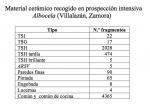Summary (English)
Research (2000-2003)
This archaeological site shows an important sequence of Imperial Roman occupation. It is identified with the city of Albocela, between the 1st Century BC and the 5th century AD. Hand made sherds, dating to the first Iron Age, were found on the surface to the N, on the small hill of Valcuevo. To the E, between the Roman archaeological site and Villalazán, there is a medieval necropolis that was partially destroyed by works of road infrastructure and terracing.
Aerial surveys detected the remains of a structure that was interpreted as a Roman military camp, and an urban road network with orthogonal structure and two different areas. Located to the N, the first part is smaller and presents a series of four roads oriented E-W , and another series of four roads oriented N-S. The orientation of the grid and that of the structures excavated in the area coincides. The second grid is located to the S. It is larger and presents four streets with oriented E-W and three oriented N-S. To the S of this grid, two parallel roads were found, interrupted in the central area by a possible entrance to the city. A high density of relevant architectural remains was found in this area: square stones blocks piled up in field borders, pieces of opus signinum and vestiges of marble veneers (crustae).
Outside the urban area, aerial photography showed other structures: to the E, it was possible to observe the path of a road leading to Ariballos creek, which in the past must have been crossed to the south of the current bridge. Highway works for the diversion route of the present road there revealed remains that seem to correspond to stone substructures of a road. It might be a section of the Iter ab Emerita Caesaraugustam ( It. Ant. 433,1-438,1).
Extensive archaeological field survey showed architectural remains (mosaic tesserae, an opus spicatum brick and two ceramic cylinders belonging to the possible hollow walls of the heating system
concameratio). Study of the abundant potsherds found indicates a higher intensity of urban occupation from the Flavian period to the early 4th century. The presence of mould-made late Hispanic Terra Sigillata demonstrates occupation of the site during the 5th century, which could even extend to a later period. Surface survey in the area of the military camp did not provide relevant material.(translation by Laura González Fernández)
- Enrique Ariño Gil y Jesús Liz Guiral
Director
- Enrique Ariño Gil (Universidad de Salamanca)
- François Didierjean (CNRS, Université de Bordeaux III)
- Jesús Liz Guiral (Universidad de Salamanca)
- Pierre Sillières (CNRS, Université de Bordeaux III)
Team
Research Body
- CNRS, Université de Bordeaux III
- Universidad de Salamanca
Funding Body
- Proyecto: Romanisation et occupation du sol dans la vallée du Duero à l’époque romaine (Programme International de Coopération Scientifique [PICS], Gobierno de Francia)






![Download [PDF]](/excavation/skins/fasti/images/results/download_sml.png)